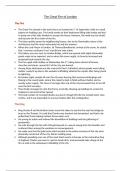The Great Fire of London
The Fire
The Great Fire started in the early hours on Sunday the 1st of September 1666 at a small
bakery on Pudding Lane. The family awoke to their bedrooms filling with smoke and had
to jump out of the attic window to escape the house. However, the maid was too afraid,
and became the first victim of the fire.
The blaze quickly spread to neighbouring houses, due to the flammable nature of the
architecture and the recent extremely hot and dry summer.
When the Lord Mayor of London, Sir Thomas Bloodworth, arrived at the scene, he stated
that ‘a woman could piss it out’ and did not take action.
The bakery was very near to London Bridge, which was packed with highly flammable
goods ready to be exported, and so when this soon caught, its ferocity increased and
projected back towards the city.
The fire raged until midday on Wednesday the 4th, taking down almost all houses,
churches and stores, around 4/5 of the city was burned.
Among those destroyed was the revered St Paul’s Cathedral, where people were taking
shelter, easily lit up due to the wooden scaffolding attached for repairs after being struck
by lightning.
By Sunday night, people all over the city were burying their precious belongings and
fleeing to the countryside, where the majority slept in fields without shelter and no
nearby water supply. The fares of carriage rides out of the city increased from £3 to £30
over the first two days.
They finally managed to calm the fire by, ironically, blowing up buildings to create fire
stoppers to prevent further spread.
The total number of recorded deaths was just 6, though this did not include lower class
victims, and it was impossible to uncover bodies after the conflagration.
The King
King Charles ll and his brother James were first taken to see the fire near the bridge by
boat on the Thames, it is said that Charles was shocked and devastated, and had to be
pulled back from helping civilians throw water on it.
He sprung to action and ordered the demolition of buildings and the gathering of
gunpowder.
He rode through the fire with 100 gold pounds in a pouch swung from his shoulder and
scattered them among the workmen in encouragement.
He made sure that the gold coins which existed as the entire economy of the city were
physically carried out of the city, before melting away.
Although presiding over one of the most lavish courts in Europe as the restorative King
of England, Charles was seen to ‘get his hands dirty’ and personally take charge of the
fire as well as the subsequent rebuilding of the city.




